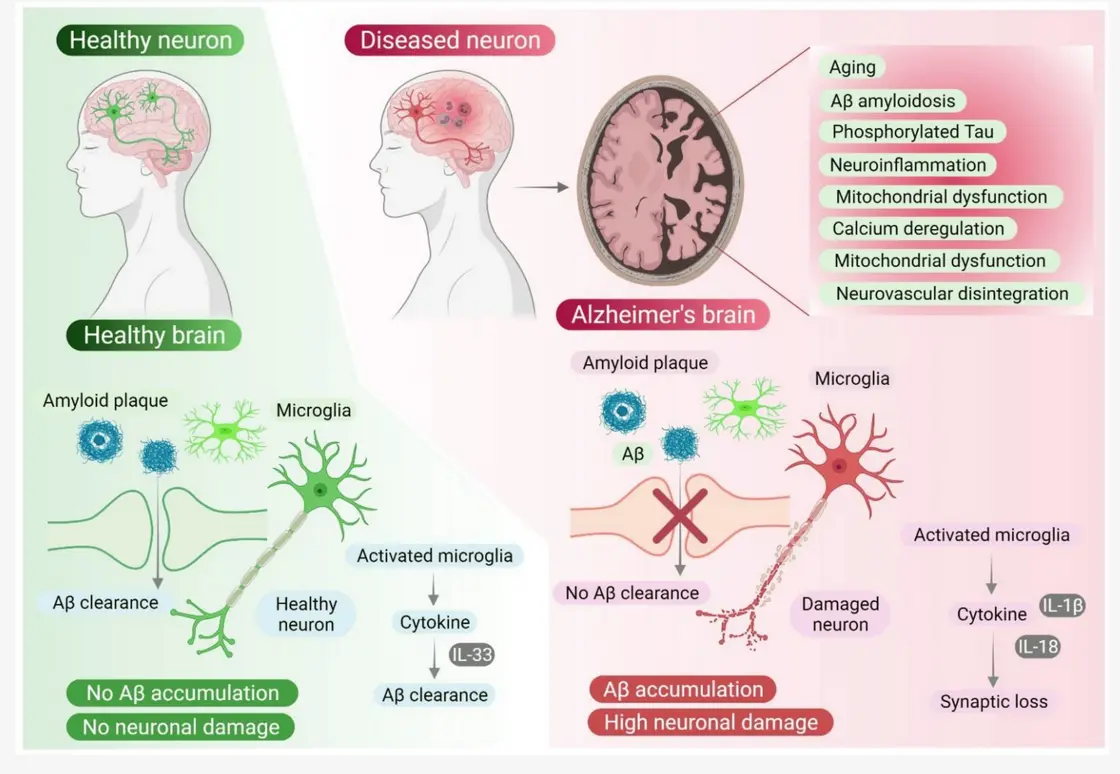Immuno-Diagnostics Antibodies and Antigens for Alzheimer's Disease (AD)
What is Alzheimer's Disease (AD)?
The most common form of dementia, Alzheimer's disease is a neurodegenerative disorder largely defined by the memory loss and subsequent drop in cognitive ability. The disease is almost always of the elderly, predominantly over the age of 65. But some people get early onset Alzheimer's disease, and start to exhibit symptoms earlier than that [1-2].
Pathological Changes
The neuropathological hallmarks of Alzheimer's disease primarily include:
1. Amyloid Plaques: These are aggregates formed from protein fragments due to the abnormal cleavage of amyloid precursor protein.
2. Neurofibrillary Tangles: These tangles occur because abnormal tau protein builds up in the cytoplasm of neurons, and disrupts the intracellular transport system.
Diagnosis
Alzheimer’s disease (AD) diagnosis involves a network of specialists to document the
distinct neuro-cognitive and neuro-structural abnormalities of the illness. They
include assessment of clinical symptoms such as memory loss that is common, poor
judgement which is early, and altered speech or behaviour. The use of imaging and
the clinical neuroposychological batterydistinguishes between AD and other dementias
based on its impairment of neuroposychological processes including memory, attention
and problem-solving abilities.
Other diagnostic tools are MRI, PET, and
functional MRI that establish hippocampal shrinkage and amyloid and tau deposition.
Biomarker testing has a significant part where the concentration of amyloid-beta
(Aβ42), phosphorylated tau (p-tau217, p-tau181, p-tau231), glial fibrillary acidic
protein (GFAP), and neurofilament light chain (NfL) in CSF or blood remarkable for
their neuropathological significance. Combined, these assessments increase
specificity therefore improving early identification and implementation of
interventions.

Figure 1. Microfluidic Platforms to Unravel Mysteries of Alzheimer's Disease: How Far Have We Come? by Pragya Prasanna / Source: Researcher.net
Validation data
Click to check the technical information
for recommended Antibodies:
Tau Products
Beta-Amyloid
Products
- p-tau181/p-tau217/p-tau231
- Aβ40/Aβ42
Good performance of GeneMedi's p-tau/tau antibodies in ELISA Validation
1. GeneMedi's three phosphorylated tau protein antibodies (p-tau181, p-tau217, and p-tau231) demonstrate outstanding sensitivity and exceptional specificity with their corresponding phosphorylated forms in direct ELISA assays.

GeneMedi's p-tau antibodies and antigens demonstrate excellent binding affinity: GMP-h-p-tau181-Ab01 effectively binds with GMP-h-p-tau181-Ag01, GMP-h-p-tau217-Ab01 binds well with GMP-h-p-tau217-Ag01, and GMP-h-p-tau231-Ab01 shows strong binding with GMP-h-p-tau231-Ag01. These results indicate that GeneMedi's p-tau antibodies and antigens possess outstanding affinity.
Product used as below:
| Cat NO. | Description |
| GMP-h-p-tau181-Ab01 | Anti-Phospho-tau181 (p-tau181) mouse monoclonal antibody (mAb) |
| GMP-h-p-tau181-Ag01 | Phospho-tau181 (p-tau181) antigen (peptide) |
| GMP-h-p-tau217-Ab01 | Anti-Phospho-tau217 (p-tau217) mouse monoclonal antibody (mAb) |
| GMP-h-p-tau217-Ag01 | Phospho-tau217 (p-tau217) antigen (peptide) |
| GMP-h-tau231-Ab01 | Anti-Phospho-tau231 (p-tau231) mouse monoclonal antibody (mAb) |
| GMP-h-p-tau231-Ag01 | Phospho-tau231 (p-tau231) antigen (peptide) |
Fig 1. Validation of GeneMedi's Anti-human p-tau181/p-tau217/p-tau231 antibody in direct ELISA.
A. GeneMedi's GMP-h-p-tau181-Ab01 (Anti-human p-tau181 antibody) is validated to detect the GMP-h-p-tau181-Ag01 (p-tau181 antigen (peptide)) in ELISA, EC50 = 25.26 ng/ml.
B. GeneMedi's GMP-h-p-tau217-Ab01 (Anti-human p-tau217 antibody) is validated to detect the GMP-h-p-tau217-Ag01 (p-tau217 antigen (peptide)) in ELISA, EC50 = 25.85 ng/ml.
C.
GeneMedi's GMP-h-p-tau231-Ab01 (Anti-human p-tau231 antibody) is validated to detect the GMP-h-p-tau231-Ag01 (p-tau231 antigen (peptide)) in ELISA, EC50 = 64.34 ng/ml.
The total tau antibody (GMP-h-TauAb01) does not interact with the p-tau181 (GMP-h-p-tau181-Ag01), p-tau217 (GMP-h-p-tau217-Ag01), and p-tau231 (GMP-h-p-tau231-Ag01) peptide antigen. (Data not shown)
2. In direct ELISA assays, GeneMedi's phosphorylated tau217 antibody demonstrates excellent sensitivity and precision for both full-length and peptide forms of the phosphorylated tau217 antigen. However, its ability to detect other phosphorylated antigens and total tau antigen is limited, indicating its highly specificity.

GeneMedi's GMP-h-p-tau217-Ab01 antibody demonstrates excellent binding ability with the full-length antigen GMP-h-p-tau217-Ag02 as well as the peptide GMP-h-p-tau217-Ag01. However, when interacting with the antigens GMP-h-p-tau181-Ag01, GMP-h-p-tau231-Ag01, and GMP-h-Tau-Ag01, the affinity is relatively weaker, as reflected by significant differences in EC50 values. These results indicate that GeneMedi's p-tau 217 antibody exhibits high affinity and specificity. Product used as below:
| Cat NO. | Description |
| GMP-h-p-tau181-Ag01 | Phospho-tau181(p-tau181) antigen (peptide) |
| GMP-h-p-tau217-Ag01 | Phospho-tau217 (p-tau217) antigen (peptide) |
| GMP-h-p-tau231-Ag01 | Phospho-tau231 (p-tau231) antigen (peptide) |
| GMP-h-p-tau217-Ag02 | Phospho-tau217 (p-tau217) antigen (full length) |
| GMP-h-Tau-Ag01 | Recombinant human MAPT/Tau/MAPTL/MTBT1 Protein |
| GMP-h-p-tau217-Ab01 | Anti-Phospho-tau217 (p-tau217) mouse monoclonal antibody (mAb) |
Fig 2. Direct ELISA Binding Curves of Phosphorylated Tau217 Antibody with Various Antigens.
This graph displays the binding efficiency of the phosphorylated tau217 antibody with five different antigens in an ELISA setup. The x-axis represents the antibody concentration in a logarithmic scale (μg/ml), and the y-axis indicates the corrected absorbance, reflecting the binding efficiency between the antibody and antigens. The data illustrate that GMP-h-p-tau217-Ab01 exhibits high detection efficiency for GMP-h-p-tau217-Ag01 (peptide) with an EC50 of 4.326 ng/ml. For GMP-h-p-tau217-Ag02 (full length), the antibody demonstrates exceptionally high sensitivity, with an EC50 of only 6.943 ng/ml. Additionally, this antibody effectively detects GMP-h-p-tau181-Ag01 (peptide), GMP-h-p-tau231-Ag01 (peptide) and GMP-h-tau-Ag01 (full length) with EC50 values of 27320 ng/ml, 3563 ng/ml and 1843 ng/ml.
3. In sandwich ELISA assays, GeneMedi's p-tau217 antibody and tau antibody pair can detect the full-length phosphorylated 217 protein but are unable to detect phosphorylated 217 peptides or non-phosphorylated proteins.

| Cat NO. | Description |
| GMP-h-p-tau217 A g01 | Phospho-tau217 (p-tau217) antigen (peptide) |
| GMP-h-p-tau217 A g02 | Phospho-tau217 (p-tau217) antigen (full length) |
| GMP-h-p-tau217 Ab01 | Anti-Phospho-tau217 (p-tau217) mouse monoclonal antibody (mAb) |
| GMP-h-p-tau217 Ab02 | Anti-Phospho-tau217 (p-tau217) mouse monoclonal antibody (mAb) |
| GMP-h-tau-A g01 | Recombinant human MAPT/Tau/MA PTL/MTBT1 Protein |
| GMP-h-tauA b01 | A nti-human MAPT/Tau/MA PTL/MTBT1 mouse monoclonal antibody (mAb) |
| GMP-h-tau-A b02 | Anti-human MAPTITau/MA PTL/MTBT1 mouse monoclonal antibody (mAb) |
| GMP-h-tau-A b03 | Anti-human MAPTITau/MA PTL/MTBT1 mouse monoclonal antibody (mAb) |
GMP-h-p-tau217-Ab01 is used as the capture antibody. When GMP-h-Tau-Ab03 is used as the detection antibody, the EC50 for detecting GMP-h-p-tau217-Ag02 is lower than GMP-h-Tau-Ab01, indicating GMP-h-Tau-Ab03 is more suitable as a detection antibody.
However, when detecting phosphorylated 217 peptide GMP-h-p-tau217-Ag01 or non-phosphorylated protein GMP-h-tau-Ag01, the EC50 remains high regardless of whether GMP-h-Tau-Ab03 or GMP-h-Tau-Ab01 is used, suggesting no binding for detecting peptide GMP-h-p-tau217-Ag01 or non-phosphorylated protein GMP-h-tau-Ag01 under these conditions.
Fig3. Sandwich ELISA Analysis of Full-Length Phosphorylated Tau 217 Antigen with Corresponding Phosphorylated Tau 217 Antibody and Total Tau Antibody.
A.This figure illustrates the detection efficacy of two different antibody combinations in Sandwich ELISA experiments targeting the GMP-h-p-tau217-Ag02 antigen (full length). The x-axis represents the antigen concentration displayed on a logarithmic scale (μg/ml), while the y-axis shows the corrected absorbance. The results indicate that the combination of GMP-h-p-tau217-Ab01 as the coating antibody and GMP-h-Tau-Ab01 as the detection antibody yields an EC50 of 76.55 ng/ml. Conversely, using GMP-h-p-tau217-Ab01 as the coating antibody and GMP-h-Tau-Ab03 as the detection antibody results in an EC50 of 39.02 ng/ml, demonstrating higher detection sensitivity at lower concentrations.
B.This figure demonstrates the detection results of two different detection antibodies (GMP-h-tau-Ab01 and GMP-h-tau-Ab03) against the GMP-h-tau-Ag01 antigen (full length) in an ELISA assay, using GMP-h-p-tau217-Ab01 as the coating antibody. The x-axis represents antigen concentration, displayed on a logarithmic scale (μg/ml); the y-axis shows corrected absorbance. The results reveal that when using GMP-h-tau-Ab03 as the detection antibody, the EC50 value reaches 20030 ng/ml, indicating a lower sensitivity to the antigen; whereas, when using GMP-h-tau-Ab01 as the detection antibody, the EC50 value soars to 4352000 ng/ml, demonstrating poor efficacy in detecting the antigen.
C. This figure illustrates the detection performance of four different antibody combinations in an ELISA assay targeting the GMP-h-p-tau217-Ag01 antigen (peptide). The x-axis represents antigen concentration, displayed on a logarithmic scale (μg/ml), while the y-axis shows the corrected absorbance. The curves in the figure show that all antibody combinations maintain relatively consistent absorbance changes across a range of low to high concentrations, indicating these results also reveal that the sensitivity of these four antibody combinations in detecting the GMP-h-p-tau217-Ag01 (peptide) antigen is relatively low.
4. GeneMedi's Tau Protein antibodies exhibit remarkable sensitivity and exceptional specificity when tested with GeneMedi’s recombinant human Tau Protein in direct ELISA assays.
Fig4. Validation of GeneMedi's Anti-human Tau antibody.
GeneMedi's GMP-h-Tau-Ab01/03/05/06/07/08/09/10/11/12 (Anti-human Tau antibody) is validated to detect the GMP-h-Tau-Ag01 (Recombinant human Tau Protein) in ELISA.

5. In sandwich ELISA assays, GeneMedi's p-tau217/tau antibody pairs can detect the full-length phosphorylated 217 protein but are unable to detect the non-phosphorylated full-length Tau protein
Fig5. Sandwich ELISA Analysis of Full-Length Phosphorylated Tau 217 Antigen with Corresponding Phosphorylated Tau 217 Antibody and Total Tau Antibody.
These figures illustrate the detection efficacy of different antibody combinations in Sandwich ELISA experiments targeting the GMP-h-p-tau217-Ag02 antigen (full length). The results show that when using GMP-h-Tau-Ab01 (A), GMP-h-Tau-Ab03 (B), GMP-h-Tau-Ab05 (C), and GMP-h-Tau-Ab06 (D), GMP-h-Tau-Ab07 (E), GMP-h-Tau-Ab08 (F), GMP-h-Tau-Ab09 (G), GMP-h-Tau-Ab10 (H), GMP-h-Tau-Ab11 (I) and GMP-h-Tau-Ab12 (J) respectively as the detection antibodies, and GMP-h-p-tau217-Ab01/03/05/06 as the coating antibody in each case. As a negative control, when the same antibody pairs target the GMP-h-Tau-Ag01 antigen (full length), the resulting EC50 is NA, which demonstrates their high specificity and sensitivity.
The table shows the EC50 values of different antibody combinations in sandwich ELISA experiments targeting the GMP-h-p-tau217-Ag02 antigen (full-length), as shown in A–J. GMP-h-p-Tau217-Ab06 shows the best EC50 in almost all antibody pairs.

6. Validation of High-Specificity p-Tau217/181/231 and Tau Antibody Pairs
The ELISA validation data demonstrates the exceptional specificity of p-Tau217/181/231 and tau antibody pairs: p-Tau217/Tau pair exclusively recognizes p-Tau217 full-length antigen (Figure A); p-Tau181/Tau pair shows selective binding to p-Tau181 full-length antigen (Figure B); p-Tau231/Tau pair specifically detects p-Tau231 full-length antigen (Figure C). The complete absence of cross-reactivity with non-target phospho-Tau isoforms confirms the superior specificity of these antibody pairs, making them ideal for precise Alzheimer's disease biomarker detection.
Fig6. High specificity and reliability of p-Tau217/181/231 and tau antibody pairs In ELISA.
A. p-Tau217/ tau antibody pair binds specifically to p-Tau217 full-length antigen.
B. p-Tau181/ tau antibody pair binds specifically to p-Tau181 full-length antigen.
C. p-Tau231/ tau antibody pair binds specifically to p-Tau231 full-length antigen.

7. High specificity and reliability of pTau217/181/231 Phosphorylated full-length protein
GeneMedi is proud to offer pTau217/181/231 phosphorylated full-length protein. As shown in Figures A, B, and C: p-Tau217 full-length antigen specifically binds to p-Tau217 antibodies (Figure A); p-Tau181 full-length antigen specifically binds to p-Tau181 antibodies (Figure B); p-Tau231 full-length antigen specifically binds to p-Tau231 antibodies (Figure C). These results demonstrate that pTau217/181/231 phosphorylated full-length antigens are phosphorylated at their respective sites, with minimal phosphorylation at other sites, ensuring high specificity and reliability for research and diagnostic applications.
Fig7. High specificity and reliability of p-Tau217/181/231 Phosphorylated Full-Length Antigens In ELISA.
A. p-Tau217 full-length antigen binds specifically to p-Tau217 antibodies.
B. p-Tau181 full-length antigen binds specifically to p-Tau181 antibodies.
C. p-Tau231 full-length antigen binds specifically to p-Tau231 antibodies.

8. Validation of High-Specificity of p-Tau217/181/231 antibodies with p-Tau217/181/231 peptides
ELISA validation data confirm the high specificity of the p-Tau217, p-Tau181, and p-Tau231 antibodies.
The p-Tau217 antibody selectively binds to the p-Tau217 peptide (Figure A), while the p-Tau181 antibody exclusively recognizes the p-Tau181 peptide (Figure B). Similarly, the p-Tau231 antibody demonstrates specific binding to the p-Tau231 peptide (Figure C). In contrast, the total-Tau antibody shows no cross-reactivity with p-Tau217, p-Tau181, or p-Tau231 peptides (Figure D). These results confirm the excellent specificity of the antibodies.
Fig8. High specificity and reliability of p-Tau217/181/231 antibodies in ELISA.
A. p-Tau217 antibody binds specifically to p-Tau217 peptide.
B. p-Tau181 antibody binds specifically to p-Tau181 peptide.
C. p-Tau231 antibody binds specifically to p-Tau231 peptide.
D. Total-Tau antibodies don't recognize p-Tau217/181/231 peptides.

9. High specificity of pTau217/181/231 peptides
GeneMedi provides high-quality pTau217, pTau181, and pTau231 peptides with well-characterized specificity.
As demonstrated in Figures A, B, and C: the pTau217 peptide exhibits selective binding to pTau217 antibodies (Figure A), the pTau181 peptide specifically interacts with pTau181 antibodies (Figure B), and the pTau231 peptide shows exclusive recognition by pTau231 antibodies (Figure C). These data confirm that each peptide is phosphorylated predominantly at its designated site, with negligible cross-phosphorylation at other residues.
Fig9. High specificity and reliability of p-Tau217/181/231 peptides in ELISA.
A. p-Tau217 peptide binds specifically to p-Tau217 antibodies.
B. p-Tau181 peptide binds specifically to p-Tau181 antibodies.
C. p-Tau231 peptide binds specifically to p-Tau231 antibodies.

Good performance of GeneMedi's Aβ40/Aβ42 antibodies in ELISA and CLIA Validation
The high-performance Aβ40 and
Aβ42 antibody raw materials developed by GeneMedi have the advantages of
good specificity and high sensitivity, and are the preferred raw materials
for the development of in vitro diagnostics reagents for Alzheimer's
disease.
In direct ELISA analysis, GMP-h-Aβ40-Ab01 and GMP-h-Aβ42-Ab01 can Recognizes
Aβ40 or Aβ42 with high specificity. GMP-h-Aβ42-Ab02 has cross-reactivity
with both Aβ40 and Aβ42.
In CLIA verification, the antibody pair (Capture: GMP-h-Aβ40-Ab01 , Detect:
GMP-h-Aβ42-Ab02 ) can detect the GMP-h-Aβ40-Ag01, and the antibody pair
(Capture: GMP-h-Aβ42-Ab02 , Detect: GMP-h-Aβ42-Ab01 ) can detect the
GMP-h-Aβ42-Ag01. Beta-amyloid(1-42) antibodies (GMP-h-Aβ42-Ab02 and
GMP-h-Aβ42-Ab01) established a standard curve, and the detection range of
Aβ42 was 100-1700 pg/mL.
Figure 1: Good performance of GeneMedi's Aβ40/Aβ42 antibodies in ELISA and CLIA Validation
A. GMP-h-Aβ40-Ab01 and GMP-h-Aβ42-Ab02 can bind GMP-h-Aβ40-Ag01, while
GMP-h-Aβ42-Ab01 can not bind the Aβ40 antigen in direct ELISA.
B. GMP-h-Aβ42-Ab01 and GMP-h-Aβ42-Ab02 can bind GMP-h-Aβ42-Ag01, while
GMP-h-Aβ40-Ab01 can not bind the Aβ42 antigen in direct ELISA.
C. CLIA verification data of the antibody pair (Capture: GMP-h-Aβ40-Ab01 ,
Detect: GMP-h-Aβ42-Ab02 ) to detect the GMP-h-Aβ40-Ag01.
D. CLIA verification data of the antibody pair (Capture: GMP-h-Aβ42-Ab02 ,
Detect: GMP-h-Aβ42-Ab01 ) to detect the GMP-h-Aβ42-Ag01.

Biomarkers for Alzheimer's Disease
| Biomarker | Limit (Pathological concentration in blood) |
|---|---|
| Phospho-tau181 (p-tau181) | >3 pg/ml |
| Phospho-tau217 (p-tau217) | >10 pg/ml |
| Phospho-tau231(p-tau231) | >10 pg/ml |
| Phospho-tau212 and 214 (p-tau212 and 214) | / |
| Phospho-tau202 and 205 (p-tau202 and 205) | / |
| Phospho-tau413 (p-tau413) | / |
| Phospho-tau422 (p-tau422) | / |
| Tau proteins (Tau) | >100 pg/ml |
| Neurofilament light chain (NfL) | >30 pg/ml |
| Glial fibrillary acid protein (GFAP) | >100 pg/ml |
| Beta-amyloid 42 (Aβ42) | / |
| Beta-amyloid 38 (Aβ38) | / |
| Beta-amyloid 40 (Aβ40) | / |
| Monocyte chemoattractant protein-1 (MCP-1/CCL2) | / |
| Neurogranin protein (Neurogranin) | / |
| Neuron-specific enolase (NSE) | / |
| sTREM2 | / |
| Visinin-like protein 1 (VLP-1) | / |
| Chitinase-3-like protein 1 (CHI3L1/YKL-40) | / |
| Alpha-synuclein (α-synuclein) | / |
| Apolipoprotein E (APOE4) | / |
| AD-associated neuronal thread protein (AD7c-NTP) | / |
| Heart fatty acid-binding protein (HFABP) | / |
Sample Types: Blood, cerebrospinal fluid (CSF)
Clinical Applications and Research in Alzheimer's Disease Diagnostics
| Name | Sample | Biomarkers | Method |
|---|---|---|---|
| Roche | Blood | P-tau217 | ECL |
| CSF | P-tau181/Aβ42 ratio | ECL | |
| Blood | P-tau181+APOE E4 | ECL | |
| C2N Diagnostics | Blood | Aβ42/40 ratio and p-tau217 ratio | LC-MS |
| Quest Diagnostics | Blood | Aβ42/40 | LC-MS/MS |
| Blood | P-tau217 | ECLIA | |
| Blood | P-tau181 | IA | |
| Quanterix | Blood | P-tau181 | Simoa |
| Blood | NfL | Simoa | |
| Blood | P-tau217 | Simoa | |
| Alzpath | Blood | P-tau217 | Simoa |
| Labcorp | Blood | P-tau217 | CLEIA |
| Blood | Aβ42/40 | CLEIA | |
| Blood | GFAP | CLEIA | |
| Blood | P-tau181 | CLEIA | |
| Blood | NfL | CLEIA |






 Full
List Download
Full
List Download 


